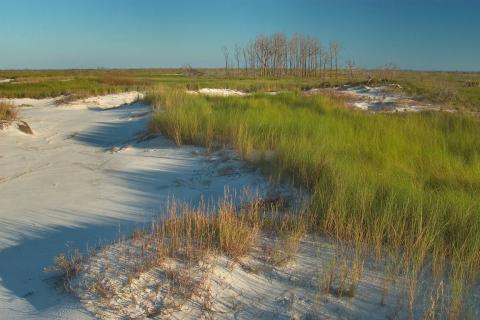The Mississippi Trustee Implementation Group (MS TIG) has released its third restoration plan. This plan addresses some of the injuries to federally managed lands, sea turtles, marine mammals, birds, and recreational uses caused by the Deepwater Horizon oil spill in the Mississippi Restoration Area.
The Mississippi Trustee Implementation Group Final Restoration Plan 3 and Environmental Assessment: Habitat Projects on Federally Managed Lands, Sea Turtles, Marine Mammals; Birds, and, Provide and Enhance Recreational Opportunities (PDF, 224 pages) evaluates a range of project alternatives and identifies the preferred project alternatives. The MS TIG considered public comments and selected seven projects for implementation:
One Habitat Project on Federally Managed Lands Restoration Project:
-
Improve Native Habitats by Removing Marine Debris from Mississippi Barrier Islands ($3,000,000)
This project will remove marine debris on Mississippi barrier islands managed by the National Park Service’s Gulf Islands National Seashore (including all of Petit Bois, Horn, and Ship islands and a portion of Cat Island). These islands are critically important areas for shorebirds, sea turtles, beach invertebrates, functioning coastal habitat, and visitor use.
One Sea Turtle Restoration Project:
-
Maintaining Enhanced Sea Turtle Stranding Network Capacity and Diagnostic Capabilities ($2,500,000)
This project will focus on maintaining the enhanced capacity of the Sea Turtle Stranding Network for three years in order to provide an enhanced ability to respond to stranded, sick, injured, or dead sea turtles. The project will also maintain the increased capacity to rehabilitate sea turtles as a result of stranding or incidental take and ultimately return them to the Mississippi Sound.
Two Marine Mammal Restoration Projects:
-
Maintaining Enhanced Marine Mammal Stranding Network Capacity and Diagnostic Capabilities ($2,350,000)
This project will focus on maintaining the enhanced capacity of the Mississippi Marine Mammal Stranding Network for three years in order to provide an enhanced ability to respond to stranded, sick, injured, or dead marine mammals.
-
Reduction of Marine Mammal-Fishery Interactions through Trawl Technique and Component Material Improvements ($3,090,000)
This project will provide restoration benefits to Gulf of Mexico common bottlenose dolphins by decreasing the number of interactions and associated mortality of dolphins in commercial shrimp skimmer trawls in Mississippi state waters, while maintaining catch efficiency and fishing performance/usability. The project will be conducted collaboratively with researchers and the fishing community.
One Bird Restoration Project:
-
Bird Stewardship and Enhanced Monitoring in Mississippi ($6,105,500)
The Bird Stewardship and Enhanced Monitoring in Mississippi project will help restore coastal nesting shorebird species by implementing stewardship activities that would reduce human disturbance of birds and predation of nests and chicks by wildlife (e.g., racoons, coyotes) and address critical information gaps for populations of colonial waterbirds breeding along the Mississippi coast. This additional critical information will better inform restoration planning.
Two Restoring Lost Recreational Use Restoration Projects:
-
Clower Thornton Nature Park Trail Improvements ($630,000)
The enhancements to Clower Thornton Park include installation of new trail/boardwalk(s) and installation of other amenities (e.g., educational kiosks, signage). In addition to the existing paved perimeter trail, new eco-friendly interior walking trails will intersect and traverse the interior of the park. The project will improve the connection between communities and natural resources and will ultimately strengthen the community’s stewardship of coastal Gulf resources.
-
Environmental Education and Stewardship at Walter Anderson Museum of Art ($1,356,000)
The project will fund the construction of the Creative Complex, which will add 15,000 square feet of indoor and outdoor educational space and gardens to the Museum campus to facilitate coastal education and recreation to promote engagement in restoration and stewardship of natural resources.
Details on the projects and the environmental analyses are in the restoration plan and environmental assessment. The restoration plan is consistent with the Trustees’ Programmatic Restoration Plan.
Public Engagement and Comment
This restoration planning effort began in October 30, 2020, with a Notice of Solicitation calling for project ideas. In June 2021, we published a Notice of Initiation of Restoration Planning in Mississippi.
A draft of this plan was released for public comment in December 2021, and we held a virtual public meeting on January 11, 2022. We considered the public comments to the restoration plan and environmental assessment. On June 3, the Mississippi Trustee Implementation Group approved a Finding of No Significant Impact associated with the Final Restoration Plan 3.
Documents
- Mississippi Trustee Implementation Group Final Restoration Plan 3 and Environmental Assessment: Habitat Projects on Federally Managed Lands; Sea Turtles; Marine Mammals; Birds; and Provide and Enhance Recreational Opportunities (PDF, 224 pages)
- Factsheet: Improve Native Habitats by Removing Marine Debris from Mississippi Barrier Islands (PDF, 2 pages)
- Factsheet: Maintaining Enhanced Sea Turtle Stranding Network Capacity and Diagnostic Capabilities (PDF, 2 pages)
- Factsheet: Maintaining Enhanced Marine Mammal Stranding Network Capacity and Diagnostic Capabilities (PDF, 2 pages)
- Factsheet: Reduction of Marine Mammal-Fishery Interactions through Trawl Technique and Component Material Improvements (PDF, 2 pages)
- Factsheet: Bird Stewardship and Enhanced Monitoring in Mississippi (PDF, 2 pages)
- Factsheet: Clower Thornton Nature Park Trail Improvements (PDF, 2 pages)
- Factsheet: Environmental Education and Stewardship at Walter Anderson Museum of Art (PDF, 2 pages)


